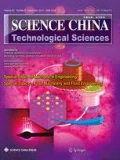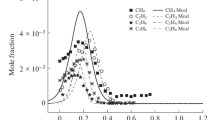Abstract
To better understand potential pollutant formations during combustion of conventional hydrocarbon fuels blended with oxygenated fuels, detailed influences of ethanol as fuel additive on small polycyclic aromatic hydrocarbons (PAHs) precursors, aldehydes, ketene and other important intermediate species in premixed fuel-rich low-pressure ethylene flames are distinguished among dilution, thermal and chemical effects of additives. Dominant effects of ethanol addition on each species are underlined respectively. Ethylene oxidation process is delayed when ethylene is substituted by ethanol. The influence of ethanol dilution and thermal effects on ethylene consumption are larger than chemical effects. CO mole fractions slightly decrease mainly as a result of dilution and thermal effects of added ethanol. The reductions in small PAHs precursors (acetylene and propargyl) are attributed to dilution and thermal effects of ethanol addition instead of chemical effects. The ethanol chemical effects promote formations of hazardous pollutants formaldehyde and acetaldehyde, and especially are responsible for the significant increase of acetaldehyde. C2H6, C4H2 and C4H4 mole fractions decrease in a similar way with acetylene and propargyl as ethanol is added. Ethanol used here only serves as a prototype of oxygenated additive, and identification method in this work is more universal which can be easily extended for analyzing other fuel blends of hydrocarbon and oxygenated fuels.
Similar content being viewed by others
References
Kohse-Höinghaus K, Oßwald P, Cool T A, et al. Biofuel combustion chemistry: From ethanol to biodiesel. Angew Chem Int Ed, 2010; 49: 3572–3597
Hsieh W D, Chen R H, Wu T L, et al. Engine performance and pollutant emission of an SI engine using ethanol-gasoline blended fuels. Atmos Environ, 2002; 36: 403–410
Yao Y C, Tsai J H, Chiang H L. Effects of ethanol-blended gasoline on air pollutant emissions from motorcycle. Sci Total Environ, 2009; 407: 5257–5262
Inala F, Senkan S M. Effects of oxygenate concentration on species mole fractions in premixed n-heptane flames. Fuel, 2005, 84: 495–503
Wu J, Song K, Litzinger T, et al. Reduction of PAH and soot in premixed ethylene–air flames by addition of ethanol. Combust Flame, 2006; 144: 675–687
Kasper T S, Oßwald P, Kamphus M, et al. Ethanol flame structure investigated by molecular beam mass spectrometry. Combust Flame, 2007; 150: 220–231
Kohse-Höinghaus K, Oßwald P, Struckmeier U, et al. The influence of ethanol addition on premixed fuel-rich propene-oxygen-argon flames. Proc Combust Inst, 2007; 31: 1119–1127
Wang J, Struckmeier U, Yang B, et al. Isomer-specific influences on the composition of reaction intermediates in dimethyl ether/propene and ethanol/propene flame. J Phys Chem A, 2008; 112: 9255–9265
Frassoldati A, Faravelli T, Ranzi E, et al. Kinetic modeling study of ethanol and dimethyl ether addition to premixed low-pressure propene-oxygen-argon flames. Combust Flame, 2011; 158: 1264–1276
Song J, Yao C, Liu S, et al. Experiment study of oxygenates impact on n-heptane flames with tunable synchrotron vacuum UV photoionization. Fuel, 2009; 88: 2297–2302
Yao C, Yang X, Raine R R, et al. The Effects of MTBE/ethanol additives on toxic species concentration in gasoline flame. Energy Fuels, 2009; 23: 3543–3548
Korobeinichev O P, Yakimov S A, Knyazkov D A, et al. A study of low-pressure premixed ethylene flame with and without ethanol using photoionization mass spectrometry and modeling. Proc Combust Inst, 2011; 33: 569–576
Gerasimov I E, Knyazkov D A, Yakimov S A, et al. Structure of atmospheric-pressure fuel-rich premixed ethylene flame with and without ethanol. Combust Flame, 2012; 159: 1840–1850
Golea D, Rezgui Y, Guemini M, et al. Reduction of PAH and soot precursors in benzene flames by addition of ethanol. J Phys Chem A, 2012; 116: 3625–3642
Dias V, Katshiatshia H M, Jeanmart H. The influence of ethanol addition on a rich premixed benzene flame at low pressure. Combust Flame, 2014; 161: 2297–2304
Bierkandt T, Kasper T, Akyildiz E, et al. Flame structure of a lowpressure laminar premixed and lightly sooting acetylene flame and the effect of ethanol addition. Proc Combust Inst, 2014; 35: 803–811
Guo Z, Lou C, Liu Z D, et al. The impact of combustion characteristics and flame structure on soot formation in oxy-enhanced and oxy-fuel diffusion flames. Sci China Tech Sci, 2013; 56: 1618–1628
Du D X, Axelbaum R L, Law C K. The influence of carbon dioxide and oxygen as additives on soot formation in diffusion flames. In: Twenty-Third Symposium (International) on Combustion, 1990. 1501–1507
Appel J, Bockhorn H, Frenklach M Y. Kinetic modeling of soot formation with detailed chemistry and physics: Laminar premixed flames of C2 hydrocarbons. Combust Flame, 2000; 121: 122–136
Marinov N M. A detailed chemical kinetic model for high temperature ethanol oxidation. Int J Chem Kinet, 1998; 31: 183–220
Kee R J, Grcar J F, Smooke M D, et al. A fortran program for modeling steady laminar one-dimensional premixed flames. Report No. SAND85-8240, Sandia National Laboratories, 1985. Modification of PREMIX version 2.5, 1991
Liu F, Guo H, Smallwood G J, et al. The chemical effects of carbon dioxide as an additive in an ethylene diffusion flame: Implications for soot and NOx formation. Combust Flame, 2001; 125: 778–787
Liu D, Santner J, Togbé C, et al. Flame structure and kinetic studies of carbon dioxide diluted dimethyl ether flames at reduced and elevated pressures. Combust Flame, 2013; 160: 2654–2668
Liu D. Kinetic analysis of the chemical effects of hydrogen addition on dimethyl ether flames. Int J Hydrogen Energy, 2014, 39: 13014–13019
Author information
Authors and Affiliations
Corresponding author
Rights and permissions
About this article
Cite this article
Liu, D. Detailed influences of ethanol as fuel additive on combustion chemistry of premixed fuel-rich ethylene flames. Sci. China Technol. Sci. 58, 1696–1704 (2015). https://doi.org/10.1007/s11431-015-5884-2
Received:
Accepted:
Published:
Issue Date:
DOI: https://doi.org/10.1007/s11431-015-5884-2




